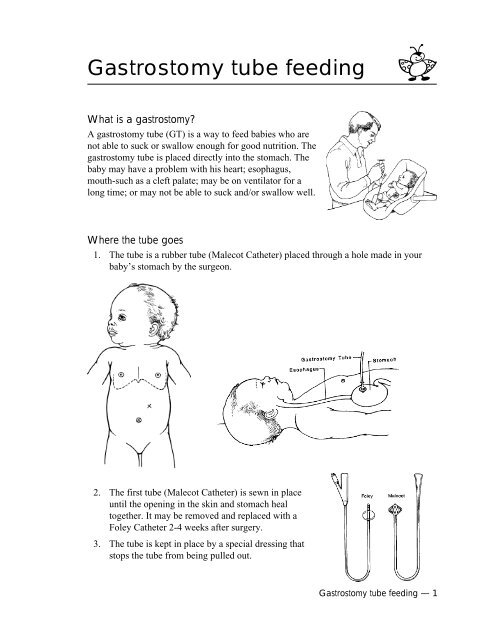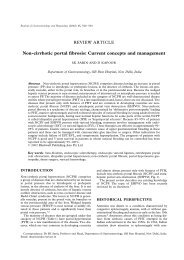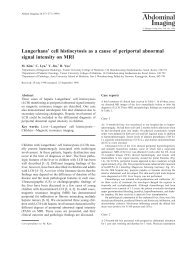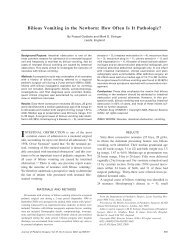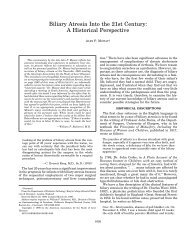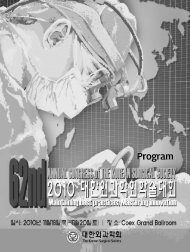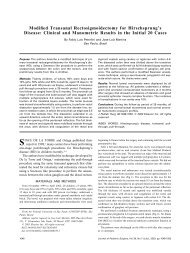Gastrostomy tube feeding - Biliaryatresia.org
Gastrostomy tube feeding - Biliaryatresia.org
Gastrostomy tube feeding - Biliaryatresia.org
Create successful ePaper yourself
Turn your PDF publications into a flip-book with our unique Google optimized e-Paper software.
<strong>Gastrostomy</strong> <strong>tube</strong> <strong>feeding</strong>What is a gastrostomy?A gastrostomy <strong>tube</strong> (GT) is a way to feed babies who arenot able to suck or swallow enough for good nutrition. Thegastrostomy <strong>tube</strong> is placed directly into the stomach. Thebaby may have a problem with his heart; esophagus,mouth-such as a cleft palate; may be on ventilator for along time; or may not be able to suck and/or swallow well.Where the <strong>tube</strong> goes1. The <strong>tube</strong> is a rubber <strong>tube</strong> (Malecot Catheter) placed through a hole made in yourbaby’s stomach by the surgeon.2. The first <strong>tube</strong> (Malecot Catheter) is sewn in placeuntil the opening in the skin and stomach healtogether. It may be removed and replaced with aFoley Catheter 2-4 weeks after surgery.3. The <strong>tube</strong> is kept in place by a special dressing thatstops the <strong>tube</strong> from being pulled out.<strong>Gastrostomy</strong> <strong>tube</strong> <strong>feeding</strong> — 1
What is a Nissen fundoplication?1. Sometimes a Nissen fundoplication is done at the same time the gastrostomy <strong>tube</strong> isplaced.2. This surgical procedure tightens the valve between the esophagus (canal connectingthe mouth anad stomach) and your baby’s stomach.3. Part of the baby’s stomach is wrapped around the esophagus, like a scarf is wrappedaround the neck.Nissen<strong>Gastrostomy</strong> <strong>tube</strong>insertion siteNissen4. It helps stop formula and stomach juices from sloshing up into the <strong>feeding</strong> <strong>tube</strong> oresophagus. This is called reflux.5. Reflux can make your baby spit-up often, irritate the esophagus, have breathingproblems (apnea) or cause formula and stomach juices to get into the baby’s lungs.What happens after surgery?1. The <strong>tube</strong> is hung in the crib or isolette to “rest” for about 24 hours.2. Feedings are usally started using the <strong>tube</strong> 2-3 days after surgery.3. Feedings are started slowly.2 — <strong>Gastrostomy</strong> <strong>tube</strong> <strong>feeding</strong>
Care of the gastrostomy <strong>tube</strong>: cleaning the stoma (opening)Supplies:Stomahesive or D-TADMild soapScissorsCloth to wash skinHy-tape 1/2 inchCloth to dry skinWaterDressing1. Gather all the supplies you need before you begin. Wash you hands!2. Remove the old dressing.3. Wash skin around the <strong>tube</strong>. Pat dry.4. Look at skin for redness or bleeding. Watch for a build-up of red or pink skinaround the stoma (opening into the stomach).5. Prepare dressing.6. Apply dressing.7. Secure dressing.8. Tube length should be checked 2 times a day to see if it has moved too far into thestomach. If this happens, pull on the <strong>tube</strong> and position it correctly. If you are notable to pull the <strong>tube</strong> back, remove the water from the Foley catheter bulb; removethe <strong>tube</strong> completely; check the <strong>tube</strong>; and put it back in the stomach.9. Depending on how dressed, dressing needs to be changed twice a week (everyMonday and Thursday for example). The dressing should be changed and the sitechecked if the area smells badly, drainage is seen, or redness and/or swelling occur.Care of irritated skinWeepy skin1. If the skin is weepy or blistered wash the area with water. Rinse well and pat dry.2. Sprinkle Stomahesive powder on weepy skin.3. Dust off extra powder. Stomahesive powder will stick to weepy skin.4. Apply dressing.5. Repeat every 3-4 days until skin is healed.6. Call the doctor if the area is not better in 1 week.<strong>Gastrostomy</strong> <strong>tube</strong> <strong>feeding</strong> — 3
Rash1. If skin looks like it has “prickly heat” or “diaper rash” wash the area with water.Rinse well and pat dry.2. Apply a THIN coat of protective cream, recommended by your doctor.3. Massage the cream into the skin and let dry.4. Apply the dressing.5. Repeat every 2-3 days until skin is healed.6. Call the doctor if the area is not better in 1 week.Changing the gastrostomy <strong>tube</strong>1. Always wash your hands before changing dressing or <strong>tube</strong>.2. The <strong>tube</strong> is not changed the first 2-4 weeks after surgery.3. If the <strong>tube</strong> comes out, the opening (stoma) may close within 3 hours, so a new <strong>tube</strong>needs to be placed before this happens.4. If you cannot replace the <strong>tube</strong>, call your doctor.5. Check Foley catheter by filling bulb end with 5 cc’s of tap water before inserting<strong>tube</strong> into baby’s stomach.6. Remove water before inserting <strong>tube</strong>.7. Wet tip of <strong>tube</strong> in tap water.8. Put tip of <strong>tube</strong> into stomach opening.9. Pass <strong>tube</strong> into the stomach about 1 inch past the bulb.10. Fill bulb with 5 cc’s of tap water.11. Gently pull <strong>tube</strong> to position bulb against the wall of stomach. Pulling <strong>tube</strong> tootightly will cause the opening to enlarge and formula may leak out around the <strong>tube</strong>.12. Clamp <strong>tube</strong>.13. Apply dressing and tape in place.4 — <strong>Gastrostomy</strong> <strong>tube</strong> <strong>feeding</strong>
FeedingSupplies:PacifierBreast milk/formulaMedicine60 cc syringe1. Make baby comfortable: change diaper, suction if needed, offer pacifier, place ininfant seat or on bed with head elevated.2. Unclamp gastrostomy <strong>tube</strong>.3. Check for milk left in stomach from last <strong>feeding</strong> (residuals) by attaching a syringeto the <strong>tube</strong> and gently pulling back on plunger. Give this material back to yourbaby. DO NOT throw this away. It contains important nutrients. If more than 15-20cc’s of milk are present, call the doctor for a possible change in <strong>feeding</strong>s.4. Remove the plunger from the syringe. Put the syringe into the open end of thegastrostomy <strong>tube</strong>.5. Pinch <strong>tube</strong> closed. Hold syringe upright.6. Pour breastmilk or formula into the syringe and add any medications. Release the<strong>tube</strong> and let the <strong>feeding</strong> begin to flow.7. Add more breastmilk or formula as the syringe empties.Pinch the <strong>tube</strong> closed when adding more breastmilk orformula. To prevent air from getting into the stomach,do not let syringe run dry.8. Feeding should run at 2-3 cc’s/minute or be finished inabout 20 minutes.9. To start the <strong>feeding</strong>, a gentle push with the plunger maybe needed.10. Feeding should FLOW BY GRAVITY, SLOWLY(hold syringe above your baby)!11. When <strong>feeding</strong> is finished, <strong>tube</strong> may be flushed with 3-5cc’s of tap water or air to clear it of formula.12. Clamp <strong>tube</strong> using a syringe cap in the open end and arubber band around the <strong>tube</strong> doubled against itself.13. Try to burp baby (probably will not burp if he had aNissen fundoplication).14. If baby seems to have stomach discomfort or enlargement, hanging the unclamped<strong>tube</strong> above your baby for 20-30 minutes may help. This lets your baby “burp”.15. After <strong>feeding</strong>, place baby on right side or on stomach with his body propped at a 30degree angle.<strong>Gastrostomy</strong> <strong>tube</strong> <strong>feeding</strong> — 5
16. Clean equipment by washing syringe with hot soapy water. Let it air dry. Store inclean towel.17. TUBE FEEDINGS ARE NOT TO BE HUNG OR LEFT UNATTENDED.Call the doctor if....1. Bloody residuals (milk left in baby’s stomach between <strong>feeding</strong>s).2. Residuals greater than 15-20 cc’s.3. Stomach enlargement not helped by unclamping and hanging the <strong>tube</strong> for 1 hour.4. Unable to replace <strong>tube</strong> that came out.5. Tissue build-up around the gastrostomy <strong>tube</strong>.6. Unpleasant smell from the stoma (opening into stomach), bleeding stoma, formulaleaking around gastrostomy <strong>tube</strong>.Other information1. Babies with gastrostomy <strong>tube</strong>s have visiting nurses or Health Department referralsto help with questions or problems when you go home.2. Before your baby goes home, parents work with a therapist to help your baby learnto suck. (This may continue at home).3. If your baby cries or strains to have a bowel movement, breastmilk or formula mayback up into the syringe. Pinch the <strong>tube</strong> closed briefly. Help calm your baby.Restart <strong>feeding</strong> when he is relaxed and quiet.4. You may hold your baby during the <strong>feeding</strong> when you feel more comfortable with<strong>feeding</strong> your baby by gastrostomy.5. Feeding by nipple should be tried before gastrostomy <strong>feeding</strong> when your baby isallowed to nipple part or all of his <strong>feeding</strong>.6. If your baby does not feed by bottle or takes most of his <strong>feeding</strong>s by <strong>tube</strong>, you maygive the one or two night <strong>feeding</strong>s by gastrostomy <strong>tube</strong>, particularly if your baby isasleep or not alert. As the baby’s bottle <strong>feeding</strong>s increase, these <strong>feeding</strong>s can be fedby bottle.Increasing <strong>feeding</strong>s1. The doctor will give you a schedule on how to increase your baby’s <strong>feeding</strong>s.Feedings are increased according to weight gained and calories needed for growth.2. Baby should be weighed once a week either at the doctor’s office or Health Unit.3. You will be given a Feeding Record to keep track of how well the baby eats. Takethis record with you to each doctor’s visit.6 — <strong>Gastrostomy</strong> <strong>tube</strong> <strong>feeding</strong>
Supplies1. All of the home supplies you need initially will be sent home with you. The hospitalmakes these arrangements with a supply company near where you live.2. The supply company will contact you at home or while you room-in withyour baby.3. Do not use the supplies for home use while you are in the hospital.4. The supply company will tell you when to reorder supplies. Call them if yourequipment breaks or to reorder supplies.5. Families with insurance should call the company or caseworker before reorderingsupplies. They may not pay for them otherwise. The insurance company will tellyou how they want this done. They work with the supply company to make sureyou have what your baby needs.<strong>Gastrostomy</strong> <strong>tube</strong> <strong>feeding</strong> — 7


